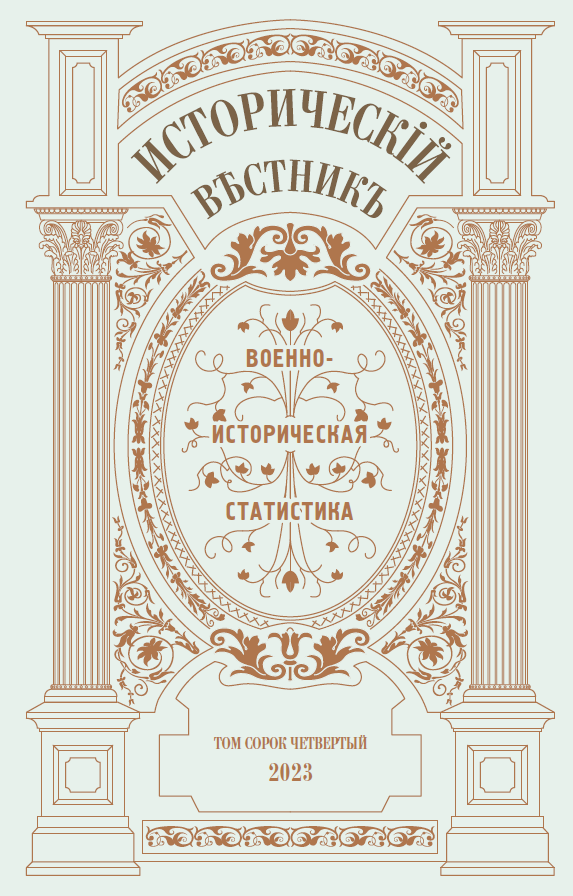MILITARY HISTORY STATISTICS
VOL. 44 [191]
june 2023
EDITORIAL
This issue of the Historical Reporter focuses on military statistics and issues of periodization and systematization of the military operations of Russia and other European countries during the part of the Modern Era that is known in Russia as the New Age (late 15th century — early 20th century). As part of the Runivers research project on military history, a team of Russian authors has made significant scientific progress in developing original methodological approaches to this vast problem. They are presented to our readers for the first time. This comprehensive approach allows for the year-on-year description and evaluation of the continuous operation of national militaries from within, using extensive statistical databases as its basis. The introductory study by Mikhail V. Baranov, Dmitriy R. Zhantiev and Oleg A. Kurbatov outlines the specific features of this approach. The approach is based on the principle of continuity in describing the structure, deployment, and actions of the armed forces during military campaigns from the 15th century to the beginning of World War I. It analyzes objective military statistics, taking military campaigns and troop deployment as the main measures of military activity both in wartime and peacetime. This enabled the analysis and evaluation of the annual military activities of every European New Age state, including the accumulation of funds, their allocation, and their use over decades and even centuries.
The pre-New Age era of the European Middle Ages needed a special methodology of statistical analysis and mapping of military campaigns because there was no centralized state mechanism for manning and maintaining the armed forces at the time. Yuri V. Seleznev’s article describes this problem in detail as it applies to Medieval Russia. The study by Oleg A. Kurbatov explores the often neglected period of the 15th to 17th centuries that featured a gradual transition from princely retinues to new organizational military structures of the centralized Russian state. Another study by Oleg Kurbatov explores the location of Peter the Great’s army garrisons in northwestern Russia. Papers by Alexander N. Chernenko (for Russia and Great Britain), Igor O. Parkhomenko (for Prussia), and Ilya Yu. Kudryashov (for France) outlines the main theoretical, methodological and practical aspects involved in the production of the Runivers databases on regiments of European states in the 18th–19th centuries. They also provide data on their numbers, accommodation sites and participation in military conflicts. Alexander V. Marey’s study deals with historical and statistical approaches to the description of the formation and evolution of the Spanish armed forces in the early modern period. To study the unique military-state activity of advancing the frontier, a specialized methodological approach is necessary. The paper by Alexey Yu. Konev presents a critical review of the works by Russian and foreign researchers, who have applied the frontier approach to the colonization and development of Siberia during the 17th–19th centuries. Additionally, the issue includes a voluminous study by Sergey G. Nelipovich, which proposes a new periodization of military operations on the Russian front of World War I, based on his research into a multitude of primary sources and historical literature. The historical-statistic methods are used to describe the formation and evolution of Spanish armed forces 1495–1497 in an article by Alexander V. Marey.
This issue of the Historical Reporter delves into a variety of topics beyond the studies conducted by the authors of the Runivers project. The Historical Thoughts section features a study written by Gregory N. Lanskoy that explores the challenges of merging geopolitical analysis with more conventional sociopolitical and sociocultural studies in domestic historical science. The Russian History section includes an article by Sergey V. Reshetnikov that examines the involvement of Soviet partisan units in the French Resistance during World War II.
We express our gratitude to Nikita G. Maksimov, editor-in-chief of Runivers for his great help in preparing this issue.
Alexey E. Titkov, Editor-in-Chief of the Historical Reporter
CONTENTS
MILITARY HISTORY STATISTICS
Mikhail V. Baranov, Dmitriy R. Zhantiev, Oleg A. Kurbatov. Military-Historical Statistics: Problems of Methodology
Yuriy V. Seleznev. Military Conflicts of Ancient and Medieval Russia: the Experience of Statistical Analysis and Mapping
Ilya E. Ulyanov. Chronology, Terminology and Periodization of the Evolution of the Light Infantry of the Russian Empire
Alexander N. Chernenko. The Database of Russian Regiments (1700–1914). Results of a Compilation Attempt. (List of Regiments, Participation in Conflicts and Military Campaigns in Europe, Establishment, Year by Year Deployment)
Alexander N. Chernenko. The Database of the Regiments of England and the Great Britain, 1661–1914. Results of a Compilation Attempt. (Regiments Roll, Conflict and Military Campaign Participation, Establishment, Deployment)
Oleg A. Kurbatov. The Russian Army of the XV–XVII Centuries. An Outline of the History of Organizational Structures
Oleg A. Kurbatov. Garrisons of the North-West of Russia (1699–1727)
Ilya Yu. Kudryashov. Database of the French Regiments
Aleksey Yu. Konev. Historiographical and Methodological Facets of the Siberian «Frontier»
Igor O. Parkhomenko. The Regiment Bases of Prussia 1665–1914
Sergey G. Nelipovich. Periodization of Military Operations on the Russian Front During the First World War
Alexander V. Marey. Spanish Tercios. Part 1. On the Eve of the Great Game
HISTORICAL THOUGHT
Grigoriy N. Lanskoy. Geopolitical Studies and Historical Science
RUSSIAN HISTORY
Stepan V. Reshetnikov. On the Issue of Recruiting Soviet Partisan Detachments from the French Resistance 1943–1944



